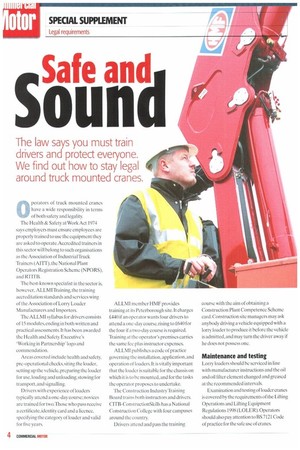Sourn
Page 62

Page 63

If you've noticed an error in this article please click here to report it so we can fix it.
The law says you must train drivers and protect everyone.
We find out how to stay legal
around truck mounted cranes.
0 perators of truck mounted cranes have a wide responsibility in terms of both safety and legality.
The Health & Safety at Work Act 1974 says employers must ensure employees are properly trained to use the equipment they are asked to operate.Accredited trainers in this sector will belong to such organisations as the Association of Industrial Truck Trainers (AITT), the National Plant Operators Registration Scheme (NPORS), and RTITB.
The best-known specialist in the sector is, however, ALLM I Training, the training accreditation standards and services wing of the Association of Lorry Loader Manufacturers and Importers.
The ALLMI syllabus for drivers consists of 15 modules, ending in both written and practical assessments. It has been awarded the Health and Safety Executive's 'Working in Partnership' logo and commendation.
Areas covered include health and safety, pre-operational cheeks, siting the loader, setting up the vehicle, preparing the loader for use, loading and unloading, stowing for transport, and signalling.
Drivers with experience of loaders typically attend a one-day course; novices are trained for two.Those who pass receive a certificate, identity card and a licence, specifying the category of loader and valid for five years. ALLMI member HMF provides training at its Peterborough site. It charges 1440 if an operator wants four drivers to attend a one-day course. rising to 1640 for the four if a two-day course is required. Training at the operator's premises carries the same fee plus instructor expenses.
ALLMI publishes a code of practice governing the installation, application, and operation of loaders. It is vitally important that the loader is suitable for the chassis on which it is to be mounted, and for the tasks the operator proposes to undertake.
The Construction IndustryTraining Board trains both instructors and drivers. CITB-ConstructionSkills has a National Construction College with four campuses around the country.
Drivers attend and pass the training course with the aim of obtaining a Construction Plant Competence Scheme card. Construction site managers may ask anybody driving a vehicle equipped with a lorry loader to produce it before the vehicle is admitted, and may turn the driver away if he does not possess one.
Maintenance and testing
Lorry loaders should be serviced in line with manufacturer instructions and the oil and oil filter element changed and greased at the recommended intervals.
Examination and testing of loader cranes is covered by the requirements of the Lifting Operations and Lifting Equipment Regulations 1998 (LOLER). Operators should also pay attention to BS 7121 Code of practice for the safe use of cranes. LOLER requires lorry mounted cranes to be thoroughly examined annually by a competent person — cg, an engineer from a reputable manufacturer such as HMFand before first use unless the loader is accompanied by a declaration of conformity, less than a year old, covering the complete installation.
Lifting accessories such as slings should he thoroughly examined at least once every six months.
BS 7121 recommends that cranes should also be fully tested before being used and again four and eight years later.The eightyear test should include non-destructive testing of the loader's structure.This involves dismantling it and crack-testing major structural components.
A full test and examination should also be carried out after each major repair, if a key structural component is changed, or if the loader is taken off and re-mounted.
All loaders should also undergo an annual test of their rated capacity pl US 10% at full radius and through their full slewing arc.
All new and secondhand lorry loaders and attachments must comply with PUWER the Provision and Use of Work Equipment Regulations 1998— as well as LOLER. Loaders and attachments manufactured after 1 January 1995 must bear a CE mark, and be accompanied by a CE certificate.
Insurance Insurers must be fully informed of all mounted cranes or the vehicle's cover may be invalidated. It may be worth taking out a specific engineering insurance policy to protect your crane against damage while being used. Your employer's liability and public liability insurers should also know you use loader cranes. Check that your goods-in-transit insurance addresses damage to cargo caused during loading and unloading with a lorry loader. •
























































































































































































































